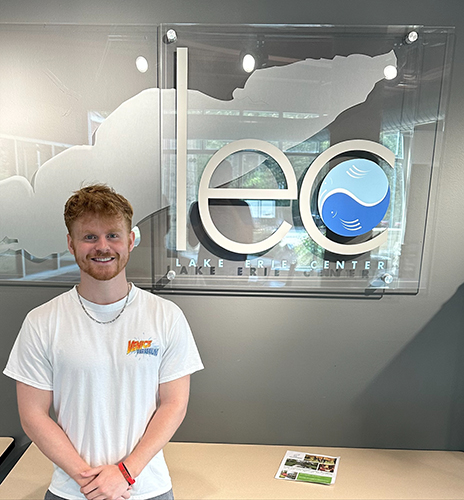In his last semester at The University of Toledo, Paul Martin has been getting to the bottom of things.
The undergraduate spent part of his summer on a research vessel on the western basin of Lake Erie, scooping up sediment layers from the bottom of the lake alongside UToledo’s Dr. Trisha Spanbauer. Then they headed to the Continental Scientific Drilling Facility in Minneapolis, where they dug into the makeup of these cores – and the stories they tell about historic harmful algal blooms.

CELEBRATING SUCCESS: UToledo recognizes the Class of 2023 with a series of stories featuring students receiving their degrees at fall commencement.
He’s incorporated their preliminary results into the honors thesis he’s writing this semester.
“This is a unique experience that I was excited to offer to one of my undergraduate researchers,” said Spanbauer, an assistant professor in the Department of Environmental Sciences. “Hands-on experiences like this are so valuable for students. I wouldn’t have gotten into science if there wasn’t such an experiential aspect to the work, and I enjoy sharing that with students.”
The research project is an example of paleolimnology, a particular research interest for Spanbauer. It’s a multidisciplinary science that uses physical, chemical and biological information preserved in sediment to reconstruct past environmental conditions in inland aquatic systems.
Martin and Spanbauer are working under a broader research initiative involving multiple institutions, including the National Oceanic and Atmospheric Administration and its Great Lakes Environmental Research Laboratory, that are investigating how cyanobacteria has changed in the Great Lakes.
Cyanobacteria are photosynthesizing bacteria that can produce toxins harmful to people and animals.
Spanbauer and other scientists are looking to ancient environmental material captured in cores to find out how cyanobacteria behaved historically: How did it deal with carbon, for example? How did temperature or pH affect its abundance in the lake?
“It’s important because looking into the past can give us a picture of where we’re headed into the future,” Spanbauer said.
The project is ongoing, and Spanbauer was out sampling again in late September.

Paul Martin is set to graduate Dec. 16 with a degree in biology with a concentration in ecology and organismal biology.
Martin, who is set to graduate Dec. 16 with a degree in biology with a concentration in ecology and organismal biology, joined the project after he began working with Spanbauer as a lab technician last summer. When an academic advisor suggested he seek out a directed research opportunity ahead of his final semester, he knew exactly who to contact.
“It was as easy as emailing her and asking, ‘Hey, can we do directed research this summer’?” he said.
Spanbauer brought him aboard NOAA’s research vessel in June, when he worked with other scientists to lower a massive claw-like piece of equipment off the side of the vessel. It scoops up sediment, which they capture in tubes that preserve it in layers that record its history.
Martin and Spanbauer took these cores to the Continental Scientific Drilling, funded by the National Science Foundation at the University of Minnesota. They analyzed them using a high-resolution point sensor to determine magnetic susceptibility and color reflectance spectrophotometry. The cores were then sent to the Large Lakes Observatory at the University of Minnesota Duluth for X-ray fluorescence analysis, which identifies the elements present in the sample based on the unique ways they behave under an intense radiation beam.
Martin said this was a highlight of the project.
“It was a really cool experience,” he said. “I really liked being able to go to a different university, and seeing their facilities and expanding my network.”
Martin, who grew up in Bowling Green, entered UToledo as a transfer student in 2020. He initially thought he wanted to pursue a career in medicine through the College of Nursing, but a first-semester course in biodiversity changed his mind and his major in short order.
As he looks toward graduation in a few weeks, he’s applying to jobs in the environmental sciences – and, of course, working on his honors thesis.
“We have the data, so now I have to analyze the data and make sense of the numbers we have in front of us,” he said. “What does this data mean, and what are the stories it will tell?”